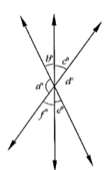In Figure, which of the
following statements must be true?
(i) a+b=d+c
(ii) a+c+e=1800
(iii) b+f=c+e
(a) (i) only
(b) (ii) only
(c) (iii) only
(d) (ii) and (iii) only

Step by step video & image solution for In Figure, which of the following statements must be true? (i) a+b=d+c (ii) a+c+e=180^0 (iii) b+f=c+e (a) (i) only (b) (ii) only (c) (iii) only (d) (ii) and (iii) only by Maths experts to help you in doubts & scoring excellent marks in Class 9 exams.
Updated on:21/07/2023Topper's Solved these Questions
Similar Questions
In Figure, which of the following statements must be true? (i) a+b=d+c (ii) a+c+e=1800 (iii) b+f=c+e (a) (i) only (b) (ii) only (c) (iii) only (d) (ii) and (iii) only

View SolutionFor the integer n , if n3 is odd, then which of the following statements are true? n is odd. II. n2 is odd. III. n2 is even (a) I only (b) II only (c) I and II only (d) I and III only
View SolutionIf x and y are negative , then which of the following statements is / are always true? x + y is positive. II xy is positive. III. x y is positive. I only (b) II only (c) III only (d) I and III only
View SolutionIf n=1+x , where x is the product of four consecutive positive integers, then which of the following is/are true? n is odd II. n is prime III. n is a perfect square. (a) I only (b) I and II only (c) I and III only (d) None of these
View SolutionIf x−y=8 , then which of the following must be true? Both x and y are positive. II. If x is negative, y must be positive III. If x is negative, y must be negative. (a) I only (b) II only (c) I and II (d) III only
View SolutionWhich of the following numbers are completely divisible by 7? I. 195195 II. 181181 III. 120120 IV. 891891 (a) Only I and II (b) Only II and III (c) Only I and IV (d) Only II and IV (e) All are divisible
View SolutionLet α and β(α<β) and c<0be the roots of x2+bx+c (1) Consider the following a) β<−α b) β<|α| which of the above is/are correct? (i) Only I (ii) Only II (iii) Both I and II (iv) Neither 1 nor 2 (2) Consider the following (i) α+β+αβ>0 (ii) α2β+β2α>0 which of the correct (a) Only I (b) Only II (c) Both (d) Neither 1 and 2 , 1 nor 2
View SolutionGiven n=1+xandx is product of four consecutive integers. Then which of the following is true? I n is an odd integer II. n is prime. III. n is a perfect square. Only I is correct (b) Only III is correct (c) Both I and II are correct (d) Both I and III are correct
View SolutionWhich of the following statement is/are always true concerning the function f(x)=x+1x (I)The graph of the function is symmetric about the y-axis. (II)The graph of the function has a relatively maximum at (1, 2) and a relative minimum at (−1, −2). (III)The graph of the function is concave up for x>0 and concave down for x<0. (a)only I (b) only II (c)only III (d) only I and II
View SolutionWhat would be the difference between the simple interest and the compound interest on a sum of the money at the end of four years? I. The rate of interest is 5 p.c.p.a. II. The sum fetches a total of Rs. 2000 as simple interest at the end of 8 years. III. The difference between the simple interest and the compound interest at the end of 2 years is Rs. 12.50. (a) II only (b) III only (c) II or III only (d) All I, II and III are required. (e) None of these
View Solution
